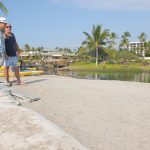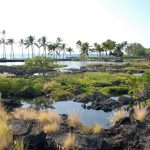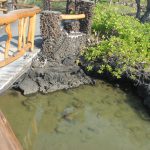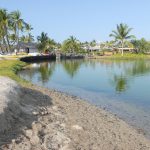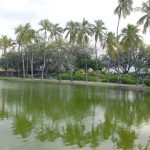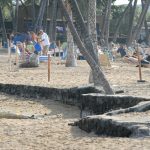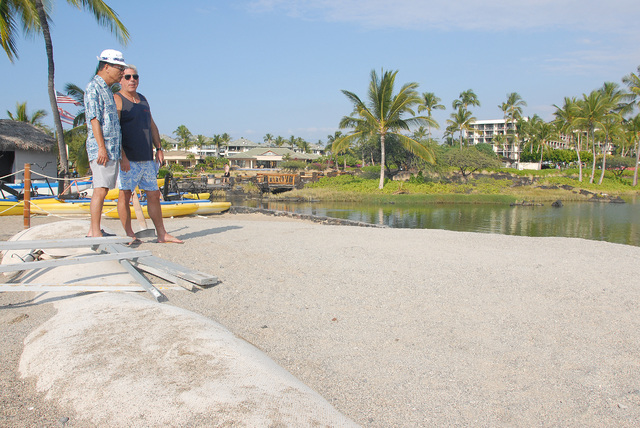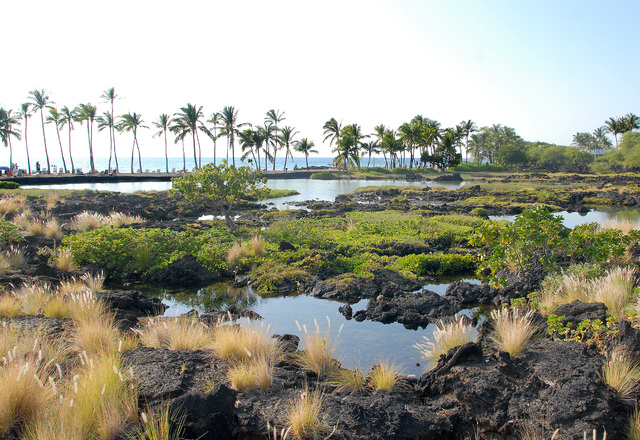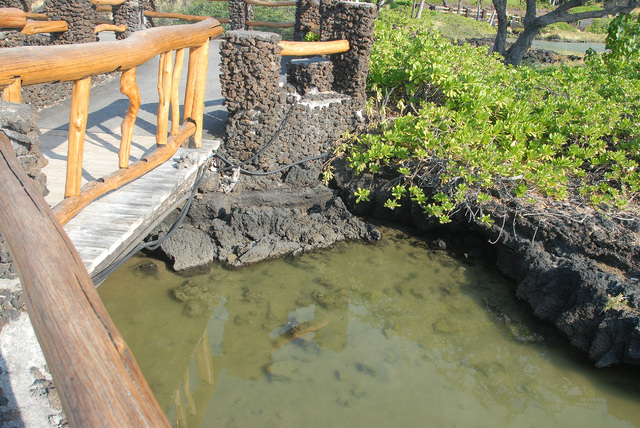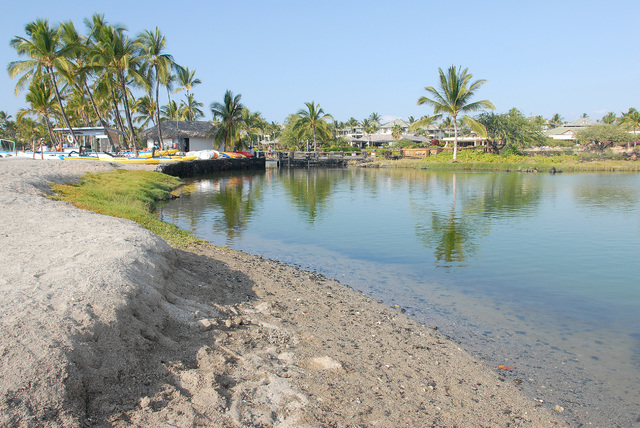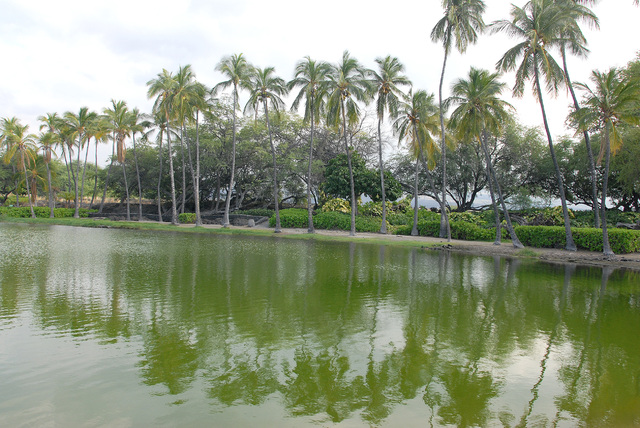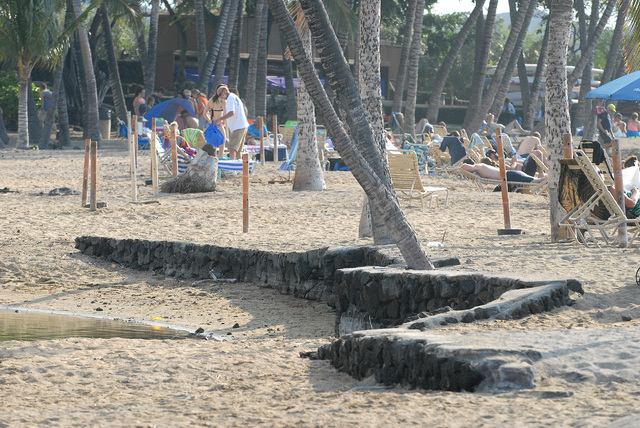ANAEHOOMALU BAY— The ancient fish ponds have turned from crystal clear to algae-ridden in the years since the March 2011 tsunami tore a 100-foot gap in the beach, damaging 220 feet of wall and allowing years of storm-driven sand to
ANAEHOOMALU BAY— The ancient fish ponds have turned from crystal clear to algae-ridden in the years since the March 2011 tsunami tore a 100-foot gap in the beach, damaging 220 feet of wall and allowing years of storm-driven sand to drift into the once clear waters.
“Soon we’ll say welcome to Anaehoomalu Bay, please prepare respiratory protection,” said resident Con Nguyen, unhappy with the lack of progress at the area as he gestured at a group of rotting plants.
But the company responsible for fixing it is possibly ready to go out for bids for the project that will repair the wall keeping the beach out of the ponds.
Sea Engineering Inc., began plans to repair the wall the day after the tsunami hit, said Scott Sullivan, chief engineer. But they’ve been delayed by a web of regulations and rules involved in working in coastal waters. It wasn’t until Feb. 22 that they received the last permit they expect to need for the project.
Although the general course of the wall was laid out centuries ago, the current wall was built some time in the mid-1980s, according to the report prepared by Sea Engineering.
The wall’s construction is somewhat of a mystery, Sullivan said, as there are no records of the construction. As a result they’ve had to rely on anecdotal evidence from longtime residents.
They won’t be positive how it was built until they begin construction, Sullivan said.
“Approximately 220 linear feet of wall was completely destroyed by the tsunami, and other sections are now leaning and appear unstable,” the report said.
The plan calls to take out the damaged parts of the wall and locate the boulders it was apparently built on. If the boulders, estimated at one ton each, have moved, they’ll be replaced. That will form a solid base to build a 6-foot-tall wall. In total, builders expect to replace 690 feet of wall.
They will be building a concrete, rubble and masonry wall in the area, which is similar to what is currently present. The initial damage to the wall was bad enough, severing lines feeding water to palm trees and taking away 9,000 cubic yards of sand.
“During the three-month period required to obtain all the necessary approvals for the emergency repair of the beach, wave action continued to enlarge the breach and scour sand from the remaining beach on both sides and move it into the bond,” the report reads about the damage sustained.
The emergency repair was a 240-feet long section of plastic fabric tubes filled with sand, called geotextile tubes in the report, or sand burritos by resident Derek Borisoff. As the years went by the beach built up and over the three tubes, leaving them still visible in a few areas.
The loss of so much sand resulted in the beach crest dropping by a foot along practically the whole area, the study said. The years since the tsunami have sent sand over the beach into the ponds and brought back 3,400 cubic yards of sand.
There are sections of the wall left, partially buried by the sand it once kept out. In some places, the drifts extend as far as 23 feet from the old wall, before dropping dramatically into the fishpond.
The delay in repairing it has led to people wondering what is going on.
“It’s not like we’re waiting on public money,” said Borisoff, who has been concerned on what’s seemed like a lack of progress.
“There never used to be any sand in here at all,” Borisoff added.
The plan is to dredge out the sand, all 800 cubic yards of it, and place it on the seaward side.
It will be combined with sand brought from a dredging project in the Haleiwa Small Boat Harbor on Oahu and used to rebuild the beach back toward its previous size. The plans call for up to 4,800 cubic yards of sand to be unloaded to restore the beach.
It’s difficult to get beach-quality sand, said Sullivan, and the company with the sand has already sold about half of the stockpiled supply the project is eyeing to use. The study said the sand is slightly coarser in grain, but will be largely indistinguishable from the local sand. As it is, the sand is rather coarse, with sections of lava, shell and coral visible.
The current plan is to use insurance settlement funds to repair and replace the wall, Sullivan said, then use any remaining money to purchase sand to replace what was lost. An estimated cost wasn’t available while the company awaits bid response.
The damage also jammed up the flow in and out of the fishponds. The water clarity has plummeted, there are fewer animals and algae grows rampant.
The area is historically significant, as it provided the anae, or mullet, for the alii. Historians believe the residents were limited to the people who tended the pond and kept away poachers.
There are a number of shelters, homes and petrogylphs nearby from that time, many surrounded by fences and accompanied by signs.
The plan said the construction will be limited to the beach area and not effect any historical sites.
There will, however, be an additional major change to the beach. Instead of removing the “sand burritos” as originally planned, the construction crews will leave them alone. The work is expected to last three weeks.
The study argues that removing them will cause damage to the beach and that they were no longer effecting littoral processes.
The area is owned by the Waikoloa Development Company, but is leased to the Waikoloa Beach Association. The association is made up of hotel owners and other resort interests. Messages left with the Department of Land and Natural Resources and the Army Corps of Engineers, both responsible for such permits, were not returned as of press time on Monday.
